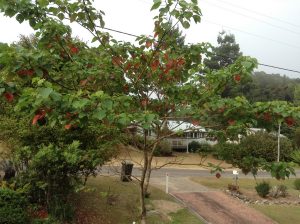Tropical Bleeding Heart Homolanthus novoguineensis
It is hard to ignore this attractive, graceful tree which is also known as Native Poplar. Its leaves are simple with a smooth, glossy upper surface and glaucous (pale bloom) underside. The stems exude a milky sap when broken. But the striking feature of this tree is the scattering of brilliant red and orange leaves among the heart-shaped green leaves. Leaves can be quite big, up to 14 cm long and 12 cm at their widest breadth and as they age, rather than a mass seasonal colouration change, a few at a time turn bright red before dropping.


The leaves actually do not turn red. As the leaf ages it ceases photosynthesizing, the green chlorophyll is taken back into the tree as stored energy. Gradually the green pigment is reduced, leaving the brilliant red and orange colouration seen in expended and dropped leaves.
The tiny flowers occur in clusters in leaf axils. They are white or cream, have no petals and are only 1 to 2 mm diameter so are often difficult to detect. Flowering can occur in any month. The fruits which follow are small green to purplish capsules about 8 to 10 mm in size which contain 2 brown seeds enclosed in yellow or orange arils. The fruit is eaten by many bird species, notably Rifle-birds, Bower-birds and Pigeons. Possums eat the leaves.
The Bleeding Heart is also the host tree for the Hercules Moth which is the largest moth in the World.
Bleeding Heart trees grow over a large area of rainforests, swamp forests and sclerophyll forests in North Queensland, NT, WA, Solomon Islands and New Guinea. They are fast growing and can grow to a height of 25 meters when buttresses may form. The tree is a forest pioneer, one of the first to re-establish after a disturbance or devastation such as a cyclone. Its presence provides shelter for other rainforest species to germinate and become established.
As you take a stroll through the village, you will see many of these trees, from seedlings only a few centimeters high to slender trees of 3 or 4 meters. After cyclone Yassi in 2011, a large number of seedlings sprung up in newly open areas around some village gardens. A good example of the tree can be seen along the McClelland’s Lookout path.
Closely related is Native Bleeding Heart, Homolanthus nutans, also known as Native Poplar. This remains usually as a shrub or small tree, growing to about 8 meters. In every other respect, including distribution, it is very similar to the Tropical Bleeding Heart.
For more information, see: Plants of Tropical North Queensland: John Beasley
Text and Photos by Colwyn Campbell
